Explore Murshidabad

The Hazarduari Palace
The palace with a thousand doors, is the chief tourist attraction of Murshidabad. Built in 1837 by Duncan McLeod for the Nawab Najim Humaun Jah, a descendant of Mir Zafar, it has a thousand doors (only 900 are real) and 114 rooms and 8 galleries. It is now a museum and has an exquisite collection of armour.
Motijheel Park
Motijheel, the cradle of British rule in India, stands witness to a remarkable turning point in Indian history. A 350 acre oxbow lake formed out of an abandoned bed of river Bhagirathi, the Motijheel, derived its name from extensive pearl cultivation during the Nawabi period. The Jheel was famous for raising golden tinted pearls extracted from unino margaritifera species.


Katra Masjid
Katra Masjid is situated about a mile in the north eastern side of Murshidabad town and is only 3 Kms from Murshidabad Railway Station. It was built by Nawab Murshid Quli Khan. The Mosque was built within 1 year by an architect named Murad Farash. Standing on a 54 mtrs high square plinth, this brick built Mosque is surrounded by a row of double storied domed cells which form a cloister to the spacious courtyard in its front.
Kathgola Gardens
Very well maintained Heritage property with many historical artifacts and unique construction material , concept used in designing the Internal Stair case.. One of the old Palace by Jains. Finely built in vast land with varieties of trees and waterbodies. There is also a Tunnel present. Full of memorabilia and artifacts of the lost times and antiques. Kathgola is a neighbourhood in the city of Murshidabad which was at one time the capital of Bengal, Bihar and Orissa during the reign of the Nawabs of Bengal.
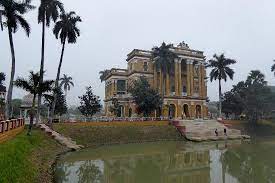

Khosh Bagh
Khosh Bagh lies on the opposite banks of Bhagirathi. The grave of Nawab Alivardi Khan, Alivardi’s Mother, Siraj-ud-Doula and his wife Lutfannesha and other members of the Nawab family lived here. The Khosh Bagh cemetery is built over 7.65 acres of land.
Jahan Kosha Cannon
Motijheel, the cradle of British rule in India, stands witness to a remarkable turning point in Indian history. A 350 acre oxbow lake formed out of an abandoned bed of river Bhagirathi, the Motijheel, derived its name from extensive pearl cultivation during the Nawabi period. The Jheel was famous for raising golden tinted pearls extracted from unino margaritifera species.

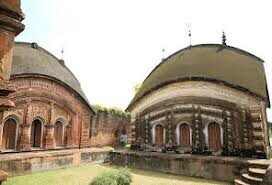
Char Bangla Temple
The centuries-old Char Bangla Mandiralaya at Baranagar is one of the most picturesque and interesting temple complexes built in Bengal. Located on the bank of the Bhagirathi River, this temple is a short boat ride upstream from Azimganj Sadarghat on the opposite bank.Some of the most famous temples that have survived the ravages of time are the Jor Bangla temple also known as Gangeswar Temple, Ek Bangla Panchanan Shiva Temple, Bhabaniswar Temple, Raj Rajeswari Temple and of course, Char Bangla Temple.
House Of Jagath Seth
House of Jagat Seth Museum contains personal possessions of Jagat Seth and his family including coins of the bygone era, muslin and other extravagant clothes, Banarasi sarees embroidered with gold and silver threads.


TOMB OF AZIMUNNISA BEGUM
Tomb of Azimunissa Begum is located at Azimnagar, in the Murshidabad district. According to the List of Monuments of National Importance in West Bengal the Tomb of Azimunissa Begum is an ASI Listed Monument.
Nasipur Palace
The Nashipur Palace was the court of Debi Singha, who was the expense gatherer of the British during the Nawabi era and was known for being a strict tax authority. It has been converted into Nashipur Rajbari museum showcasing personal belongings of the Nashipur royal family, farmans, legal documents pertaining to tax collection of that time, and other things. The royal palace also has a temple of Ramchandra, which is one of the largest temples across Murshidabad.


Imambara
The Nizamat Imambara is a Shia Muslim congregation hall in Murshidabad, India. The present Nizamat Imambara was built in 1847 AD by Nawab Mansur Ali Khan. It was built after the old Imambara built by Nawab Siraj ud-Daulah was destroyed by the fires of 1842 and 1846. This Imambara is the largest one in India and Bengal.
Kiriteswari Temple
Kiriteswari Temple is situated in Kiritkona village under the Nabagram in Murshidabad district in the state of West Bengal. This is one of the Sati peeth among the 51 peeths.
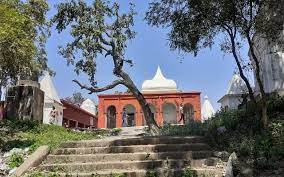

Jalangi River
The Jalangi River is an arm or distributary of the Ganges river that originates from Ganges or Padma near Bhagawangola in the Murshidabad district of West Bengal. The length of the river 233 km, and it discharges into Bhagirathi-Hooghly near Nabadwip in West Bengal.
Motijheel Mosque and Cemetery
The Motijheel Mosque and cemetery has a very important place in the history of Murshidabad. Mawazesh Md. Khan, son-in-law of Nawab Ali Vardi Khan and subedar of then Bengal, Bihar and Odisha, and Ekramoddulla, younger brother of Nawab Sirajuddullah, are buried here. Motijheel is a horse-shoe shaped lake. And in a palace adjoining it, which now lie in ruins, was the home of Warren Hastings when he became the political president at the Durbar of the Nawab Nazim. The tombs lie to the east of the mosque.


Tomb of Siraj-ud-Daulah
On this great festival of independence, the contribution of Nawab Siraj-ud-Daulah to save the independence of Bengal is worth remembering. The main purpose of the Murshidabad visit was to visit the tomb of Nawab Sirajuddaula, which is situated on the west bank of the Hooghly river in Khushbagh, along with getting acquainted with the historical buildings and monuments situated in Murshidabad West Bengal.
Old Cossimbazar (Berhampore) Palace
Cossimbazar emerged as a port town in the 17th century, and its history can be traced to the pre-emergence of Murshidabad. By the middle of the century, the Dutch, French and British had already established their trading posts (often referred to as factories) in Cossimbazar. Known for its exotic silk, the town attracted traders from far and wide turning the small settlement into an international trading hub.

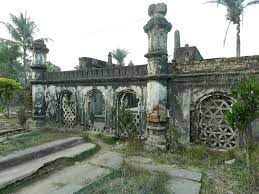
Jafarganj Cemetery
Jafarganj Cemetery was built by Mir Jafar over an area of 3.51 acres within an enclosure of waved walls, about half a mile north to the Nizamat Fort Campus and inside the campus of Namak Haram Deorhi. It hosts the graves of the later Nawabs of Bengals of the Najafi dynasty, starting from Mir Jafar, and their family members while Khushbagh, which was built by Nawab Alivardi Khan, hosts the graves of the Nawabs of Bengal belonging to the Afshar dynasty and their family members. At present this graveyard is controlled and maintained by the Archaeological Survey of India.
Wasef Manzil
The palace is smaller but equally beautiful. In addition to the architecture, the numerous marble statues it houses are sure to catch your eye. The palace used to have an artificial hill and landscape on its side which got destroyed along with most of the palace in the earthquakes of 1867.


Tomb of Alivardi Khan
Tomb of Alivardi Khan is a popular cemetery situated in reverse bank of Bhagirathi river of Murshidabad in West Bengal. It is also known as Khushbagh or Garden of Happyness. It buries Alivardi Khan, the nawab of Bengal. Apart from Alivardi Khan, this place is also reputed as the burial place of his mother, his grandson, Nawab Siraj-ud-Dulah and his grandson’s wife Luff-un-nisa. Basically, Tomb of Alivardi Khan hosts the graves of the rulers of Bengal who belong to the Afsar family.
Footi Mosque
Futi Mosque is a mosque in the city of Kumarpur, India which was built by Nawab Sarfaraz Khan in 1740 AD. The old Futi Masjid is one of the largest mosques in the town of Kumarpur and Murshidabad. It is about 3 quarters of a mile away from the grand and famous Hazarduari Palace. This grand mosque is 135 feet long and 38 feet broad.
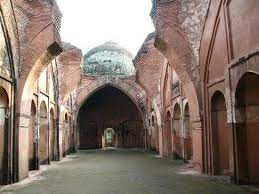

Azimganj
The Char Bangla Temple at Baranagar in Azimganj is an exquisite example of Bengal Temple architecture. The temples were built under the patronage of Rani Bhabani of Natore (now in Bangladesh) during the 18th century.
Bhavaniswar Mandir
The Bhavaniswar Mandir at Baranagar was built in 1755 by Tarasundari, daughter of Rani Bhabani. It is the tallest lime and mortar temple at Baranagar. According to Shyamal Chaterji, researcher on Hindu iconography, the “inverted lotus-like dome of this 18 M tall temple and a circular corridor around the inner sanctum are note-worthy features. Human figures on the outer facade are average.


Tripolia Gate
Tripolia Gate is located in Murshidabad. Before you head to Murshidabad, plan trip itinerary details with our user-friendly Murshidabad vacation planner, to make sure you see all that Murshidabad has to offer, including Tripolia Gate.
Yellow Mosque
Murshidabad traveler area has numerous unbelievable vacationer places like Yellow Mosque and different spots to visit in Murshidabad. Yellow Mosque is likewise one of the celebrated places in Murshidabad to visit for occasions with your family or companions. Murshidabad climate and temperature in Murshidabad the two offers great and ideal comfortable condition to voyagers to make a trip best places to visit in Murshidabad at all measure of time.


Nimak Haram Deori
Nimak Haram Deori is the main gate leading to Mir Jafar, the traitor’s palace Jafargunj. It is located at a distance of only 1 Kilometer north from the magnificant Hazarduari. Visitors cannot enter into the palace as it is well guarded. This palace stands as the memorial of the darkest hour in the history of Bengal as Nawab Siraj-ud-Daulah was killed here in an act of the betrayal. This assassination was decisive in the colonization of Bengal and India.

Dutch Cemetery
The Dutch Cemetery is located next to the Cossimbazar railway station at Kalkapur where the Dutch owned huge factories in the year 1666 AD were based. The grandeur of the Dutch has been ruined and small tombs of 43 in number remain to this day. Most of the monuments were built between 1721 and 1792 AD. The oldest monument at the Dutch cemetery belongs to Daniel van der Muyl who died in 1721. Most of the monuments are pyramidal in shape with cenotaphs mentioning the names.
